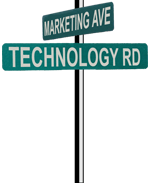 Laura Patterson, president and co-founder of VisionEdge Marketing, Inc., recently published an article that suggests marketing technology is a critical component of any marketing plan or strategy. However, she concedes there is a lot of noise for marketers to filter through before deciding which technologies will work best for them.
Laura Patterson, president and co-founder of VisionEdge Marketing, Inc., recently published an article that suggests marketing technology is a critical component of any marketing plan or strategy. However, she concedes there is a lot of noise for marketers to filter through before deciding which technologies will work best for them.
Patterson suggests,
If you want to optimize the performance of your Marketing organization and become more efficient and successful, you must know how to identify which technologies are needed, in which order, and how to effectively implement and use the tools.
So where do you begin?
At it’s heart, marketing technology is designed to make day-to-day marketing tactics easier, more organized and in some cases, execute them as well. In recent years, marketing technology has really taken off and is showing no signs of slowing down. In fact, 60% of B2B marketers believe marketing technology will be critical in two years, according to ITSMA’s David Munn.
Patterson suggests considering the work your marketing team performs as a starting point.
Phil Kotler, currently the S. C. Johnson Distinguished Professor of International Marketing at the Kellogg School of Management at Northwestern University, suggests marketing has three responsibilities: find customers, keep customers, and grow the value of customers. According to Patterson, the technology marketers employ should “optimize these capabilities, our ability to make customer-facing, creating, and engaging decisions, and prove the value of marketing.”
When it comes to winning new customers, keeping current customers and growing new relationships, marketers don’t have to look any further than lifecycle marketing.
Right On Interactive offers marketers the unique ability to find and market to new customers, keep current customers and build lasting relationships with those customers all from the same platform. By using 3D Scoring, marketers can determine their ideal customer and reach out to them with highly targeted campaigns, but ROI doesn’t stop there. With the Lifecycle Map, marketers can actually see their prospective and current customers and their location within their brand’s customer lifecycle. Nurturing campaigns can be deployed and sent to various segments, building relationships with customers than can lead to brand loyalty as well as repeat and referral business. What’s more is this is all done while providing marketers with robust analytics so they know what works and what doesn’t, helping to evolve campaigns to achieve marketing success.
To learn more about lifecycle marketing, check out this brief video.
Solution Walkthrough